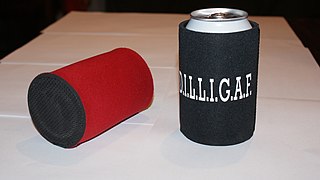
Sir James Dewar was a British chemist and physicist. He is best known for his invention of the vacuum flask, which he used in conjunction with research into the liquefaction of gases. He also studied atomic and molecular spectroscopy, working in these fields for more than 25 years.

A vacuum flask is an insulating storage vessel that greatly lengthens the time over which its contents remain hotter or cooler than the flask's surroundings by trying to be as adiabatic as possible. Invented by Sir James Dewar in 1892, the vacuum flask consists of two flasks, placed one within the other and joined at the neck. The gap between the two flasks is partially evacuated of air, creating a near-vacuum which significantly reduces heat transfer by conduction or convection. When used to hold cold liquids, this also virtually eliminates condensation on the outside of the flask.

A lunch box refers to a hand-held container used to transport food, usually to work or to school. It is commonly made of metal or plastic, is reasonably airtight and often has a handle for carrying.

The German Patent and Trade Mark Office is the German national patent office, with headquarters in Munich, and offices in Berlin and Jena. In 2006 it employed 2556 people, of which about 700 were patent examiners.
Victor Samuel Johnson Jr. was an American lawyer who was president of Aladdin Industries, a manufacturer of vacuum bottles, kerosene lamps, and stoves. He was notable for creating the market for decorative lunch boxes. The company was further diversified under Johnson's leadership. He was a businessman in Nashville, Tennessee.
Tiger Corporation is a Japanese manufacturer that applies vacuum insulation and heat control technology to consumer electronic appliances. Their headquarters are located in Kadoma City in Osaka, Japan. The company manufactures and sells appliances such as household and commercial vacuum insulated containers and stainless-steel bottles, along with cooking appliances such as rice cookers. The company also manufactures industrial parts and products used in automobiles, homes, air conditioners, space, and medical care in 60 countries around the world.

Sigg Switzerland AG is a Swiss manufacturing company with its headquarters in Frauenfeld. Sigg bottles are bottles designed and manufactured in Switzerland from aluminum and polypropylene or in China from stainless steel and glass. The company is famous because of the iconic shape its classic bottle and numerous designs which have led to its addition to the permanent design collection of the New York Museum of Modern Art.
Insulated shipping containers are a type of packaging used to ship temperature sensitive products such as foods, pharmaceuticals, organs, blood, biologic materials, vaccines and chemicals. They are used as part of a cold chain to help maintain product freshness and efficacy. The term can also refer to insulated intermodal containers or insulated swap bodies.

A koozie (US) or stubby holder (Australian) is a fabric or foam sleeve that is designed to thermally insulate a beverage container, like a can or bottle.

Stanley is an American brand of food and beverage containers invented by William Stanley Jr.

Aladdin is a brand notable for its line of character lunchboxes including Hopalong Cassidy, Superman, Mickey Mouse and The Jetsons. Today, Aladdin continues to be a food and beverage products brand and is owned by Pacific Market International, LLC of Seattle, Washington and Aladdin continues to be a kerosene lamps and wicks products brand and is owned by Hattersley Aladdin Ltd of the United Kingdom.
The American Thermos Bottle Company Laurel Hill Plant, located in the Laurel Hill section of Norwich, Connecticut, in the United States, includes 11 contributing buildings and two other contributing structures. The original plant was built during 1912–13 and used a historic Italianate house as a company office building. The plant was the primary factory where Thermos brand vacuum flask bottles were manufactured from 1913 to 1984. The plant is historically significant to its connection to the Thermos Company and the history of Norwich. The complex is architecturally significant because it displays the adaptive use of industrial mill design to new industry. It was added to the National Register of Historic Places in 1989.

Matheson Tri-Gas, Inc. produces industrial, medical, and specialty gases, and associated gas handling equipment, in North America. MATHESON offers semiconductor, medical, welding, atmospheric gases, rare gases delivered via pipelines, onsite generators, bulk tanks, and in gas cylinders to customers using gases in their labs, semiconductor fabs, hospitals, chemical plants, manufacturing and many other processes. Furthermore, MATHESON also designs and manufactures gas purification systems, generators, delivery systems, filters, gas purifiers, detection equipment, control valves, and management accessories; and gas cylinder enclosures, source manifolds, and panels, as well as helium recovery solutions. In addition, the company provides support, engineering, and systems management services to analytical laboratories and semiconductor manufacturers worldwide.

The Laurel Hill Historic District is a predominantly residential historic district south of downtown Norwich, Connecticut. The district was added to the National Register of Historic Places on October 26, 1987. It extends south from the Shetucket River along Laurel Hill Avenue, River Avenue, and Spruce Street. This area was developed as a residential district beginning in 1850, and includes a significant number of well-preserved Italianate and Gothic Revival houses.

Emsa GmbH is an innovative medium-sized (SME) German manufacturer of consumer goods, kitchen utensils, garden equipment and garden accessories who has achieved to establish an internationally recognized trademark for a variety of niches.
Adolf Ferdinand Weinhold was a German chemist, physician and inventor.

Nippon Sanso Holdings Corporation, commonly known as NSHD, is a Japanese multinational industrial gas manufacturer incorporated in the year 1910 as Nippon Sanso Corporation. The company was founded in 1918.

Juno was a German brand of cigarettes, owned and manufactured by Reemtsma, a subsidiary of Imperial Tobacco. The brand was discontinued in 2016.
Hexagames was a German game publisher in Dreieich, which existed from 1982 to 1992. It was one of the most famous German game publishers of the 1980s, notable for publishing games such as Lines of Action (1988) and Cosmic Encounter (1992).












